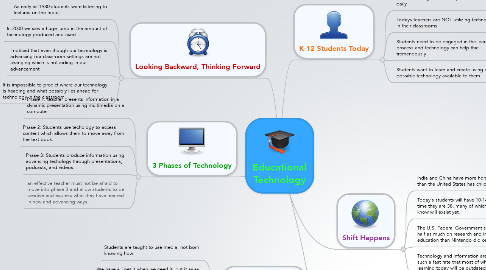Educational Technology
by Danielle Gerke

1. Looking Backward, Thinking Forward
1.1. As early as 1930 students were listening to lectures on the radio
1.2. In 2000 we saw a huge jump in the amount of technology produced and used
1.3. I noticed that even though our technology is advancing our classroom settings are not changing which is not aiding in our advancement
1.4. It is impossible to predict where our technology is heading and what possibly lies ahead for technology in the classroom.
2. 3 Phases of Technology
2.1. Phase 1: teacher presents information in a dynamic presentation using multimedia on a computer
2.2. Phase 2: Students use techology to access content which allows them to move away from the text book.
2.3. Phase 3: Students produce information using advancing techology through presentations, podcasts, and videos.
2.4. an effective teacher must not be afraid to move into phase 3 and allow students to be creative and express what they have learned in new and advancing ways.
3. 21st Century Learners
3.1. Students are taught to use media, not born knowing how.
3.2. We have a "get it when we need it, put it away when we don't" philosophy when it comes to technology.
3.3. techology needs to be linked throughout the entire community, not just in schools and at home.
3.4. we don't need to move completely away from formal learning, but need to find a better way of integrating it with informal methods of learning.
4. K-12 Students Today
4.1. Students will spend 3 1/2 hours gaming, 16 1/2 hours watching t.v., but only 2 hours reading, daily.
4.2. Todays teachers are NOT utilizing technology in their classrooms
4.3. Students need to be engaged in the learning process and technology can help thie tremendously
4.4. Students want to learn and create using every possible technology available to them.
5. Shift Happens
5.1. India and China have more honor students than the United States has children.
5.2. Today's students will have 10-14 jobs by the time they are 38, many of which we don't even know will exsist yet.
5.3. The U.S. Federal Government spent less than half as much on research and innovation in education than Nintendo did on research.
5.4. Technology and information are chaning at such a fast rate that most of what we are learning today will be outdated in 2-3 years.


